Alienware 18 Gaming Notebook Review
by Dustin Sklavos on September 16, 2013 12:00 PM ESTThe aforementioned issues with the NVIDIA GeForce GTX 780M don't prevent it from turning in an excellent performance, just not the one we'd hoped for. That in mind, the two 780Ms in the Alienware 18 are still able to offer a fantastic gaming experience with a decent amount of headroom.
Results for our "Value" benchmarks are in Bench but not really necessary when you're dealing with this much gaming horsepower. For academic purposes I'll trot out the "Mainstream" benchmarks before hitting the high end where the Alienware 18 will really shine.
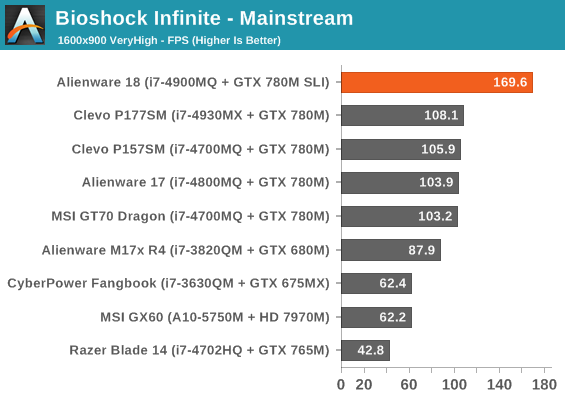

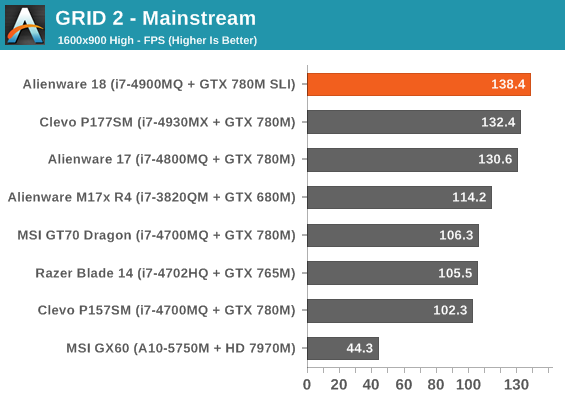

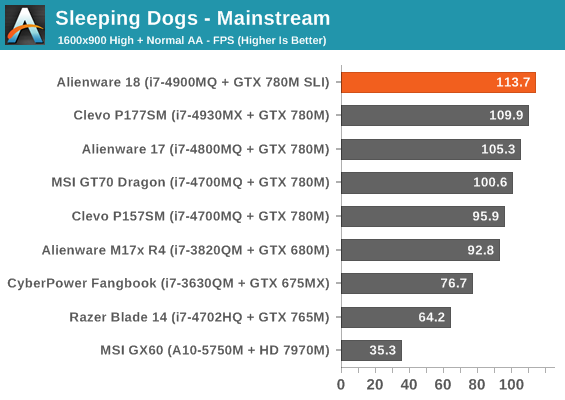
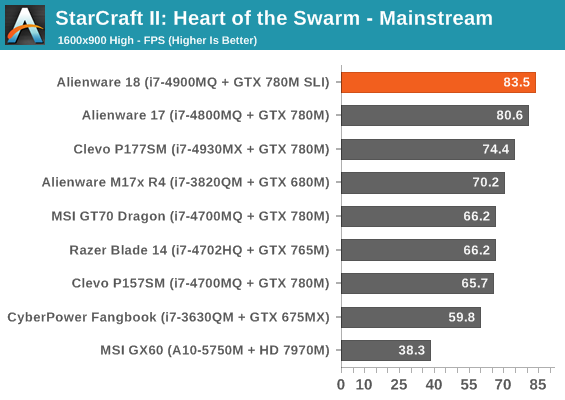
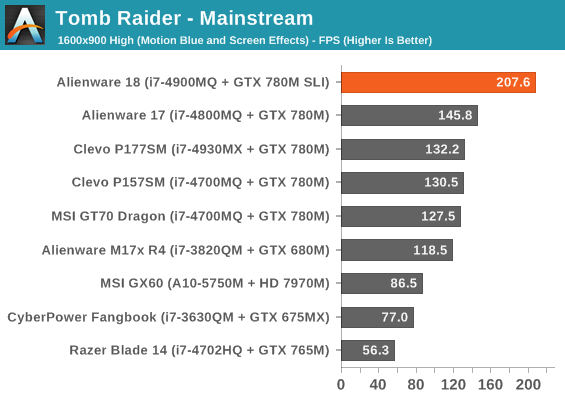
The mainstream benchmarks are at least helpful for teasing out which games are more CPU limited versus which ones are more GPU limited. Skyrim and StarCraft II are old hands, but we've found GRiD 2 to also be a bit exacting on the CPU. Of course, the enthusiast class 1080p benchmarks are where the two GTX 780Ms in SLI will really stretch their legs, and for these we've included performance data from a desktop system with an overclocked i7-4770K and GeForce GTX 780 as a point of comparison.
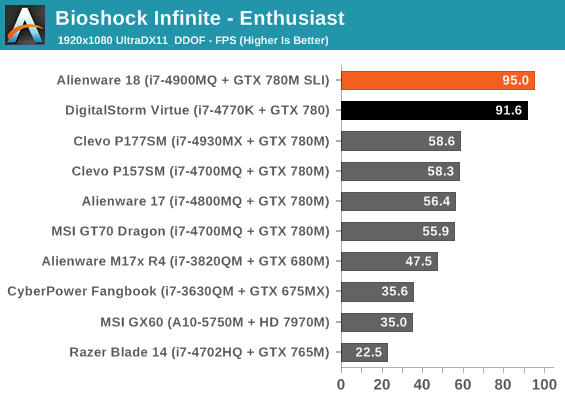
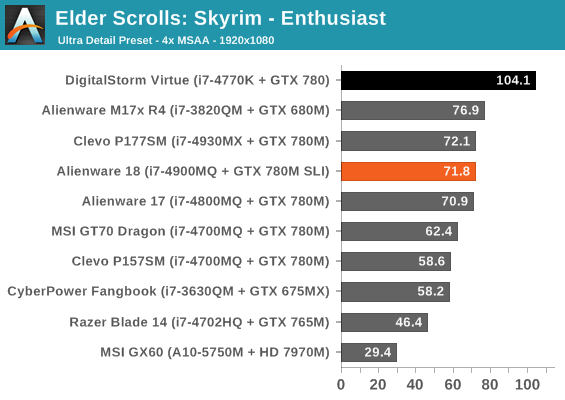
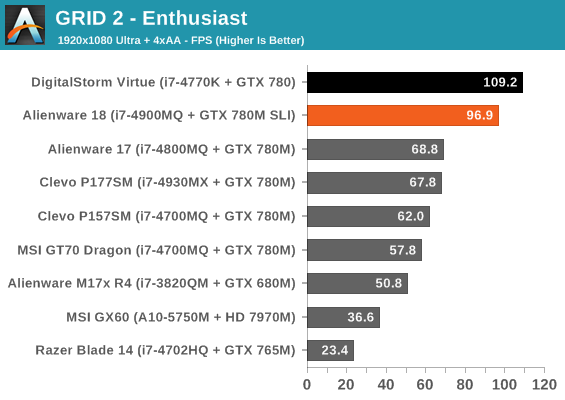
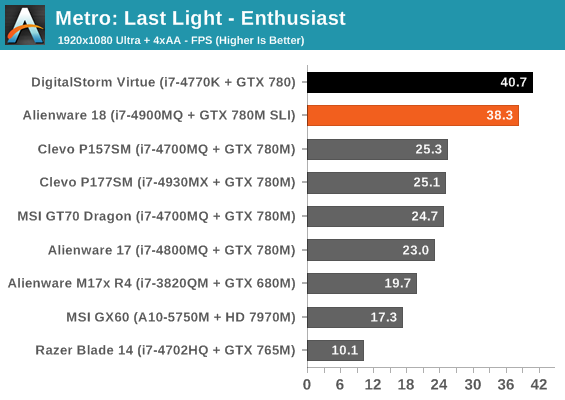
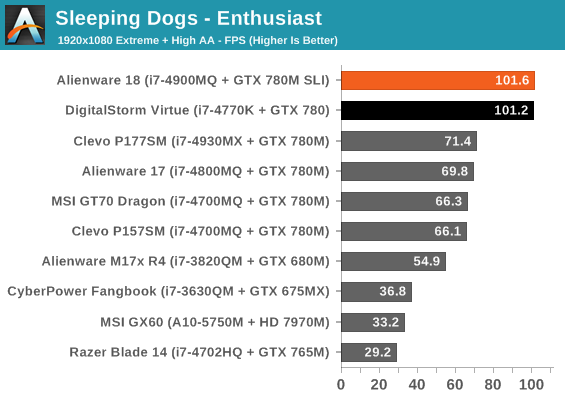
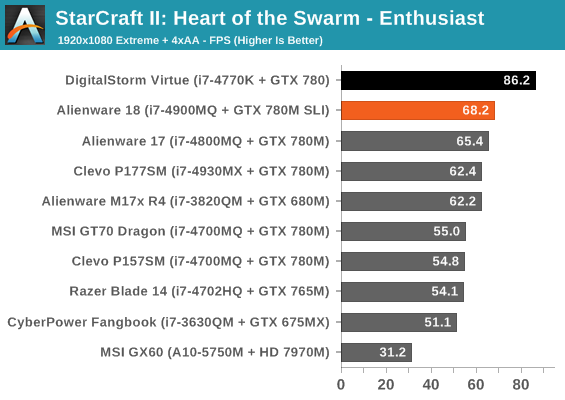
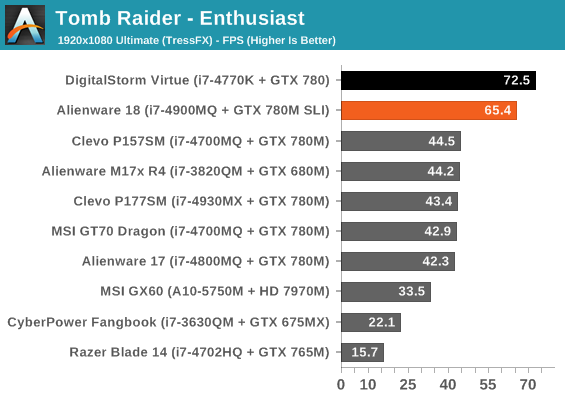
Skyrim and StarCraft II continue to scarcely benefit from the extra GPU horsepower, and keep in mind that SLI does have CPU overhead, but every other game gets a healthy boost. Unfortunately a single desktop GTX 780 paired with a 4.4GHz Haswell chip is still at least as fast or faster. While there are games that obviously need more CPU power, I honestly think the Alienware 18 would benefit as a whole from a jump to the much more expensive i7-4930MX. That puts the buyer in an unfortunate position; the 18 is already very expensive to begin with, but if you want to get the most out of your multi-GPU configuration you're probably going to want to have the extra headroom the i7-4930MX will give you to play with, which is a $500 upgrade on top of the highest end stock model.










60 Comments
View All Comments
DanNeely - Tuesday, September 17, 2013 - link
Considering that Dell didn't have the 780m's in the review model available to order when the article was published due to a supply shortage any argument that begins "Dell ought to be able to source X" is clearly suspect.Notmyusualid - Monday, September 16, 2013 - link
Yes, not far off pal.2133MHz is availabe in sodimm, but runs at a lazy CAS12. That I can do with my 1866MHz sodimm, but I keep it at 1866MHz, and CAS9. I do however have to run it at 1.6V.
Here:
Manufacturer Kingston Technology Company
Manufacturer Part Number KHX21S12P1K2/8
Manufacturer Website Address http://www.kingston.com
Brand Name Kingston
Product Line HyperX PnP
Product Name 8GB 2133MHz DDR3 Non-ECC CL12 SODIMM (Kit of 2) HyperX Plug n Play
Product Type RAM Module
madmilk - Monday, September 16, 2013 - link
DDR3-1600 is fine. The big bandwidth hog is the iGPU, but no one cares about a couple extra percent in iGPU performance on a laptop with discrete graphics.ShieTar - Tuesday, September 17, 2013 - link
I read some German magazines who have the tendency to run gaming benchmarks every year or so, and its been a long time since you could get any relevant performance boost out of higher than normal DDR speeds with an INTEL CPU. All you get from 2400 vs 1600 is about a 2% to 4% boost in performance, if you're lucky.As far as what kind of memory you will need in 5 years, that is total guessing on your part. Game developers will use what is widely available, and with the new generation of gaming consoles getting a big increase in memory, and PC systems starting to look at 8GB at the low-end configuration, it is entirely possible that a game released in 2015, 2016 will happily use up 16GB of memory when set to high settings. Nevermind the fact that a lot of people have plenty of background tasks running on their machines when gaming. Personally I am happy with 16GB right now, but I would not mind getting 32GB on a laptop which I would plan to use for 3-5 years.
DanNeely - Tuesday, September 17, 2013 - link
While the amount is debatable, I'm almost certain the type answer for 5years from now will be DDR4 for anything new. It's expected to finally launch with Haswell-EX next year; with Skylake bringing to the mainstream in 2015/16.Having recently bumped against 12GB in my aging LGA1366 box, I'm intending to go directly to 32GB in my Haswell system and hope that continued CPU stagnation will let me just buy new GPUs until 2017 or 18.
Pathfindercod - Tuesday, September 17, 2013 - link
the low voltage 1.35v ram is the ONLY ram the mobile haswell chipset supports, they had no option.Pathfindercod - Tuesday, September 17, 2013 - link
Glossy is the only option available from lcd manufacturers in the 18.4 inch size.prophet001 - Monday, September 16, 2013 - link
Why do they put all these weak resolution screens on notebooks nowadays.brucek2 - Monday, September 16, 2013 - link
a) on a gaming machine like this, you can't exceed the resolution your GPUs can drive. So 1600p is out.b) on mass market machines sold at retail, consumers will in part base their decision on how the screen looks to them. The default approach of Windows and its applications to a high resolution screen in a tiny amount of space is just to make everything look really, really tiny. So the customer moves on to the next unit.
c) Cost. Always a factor. Even if just to draw the customer in to a discussion that will soon result in upselling to a better display, you need that base model with the lowest possible cost to even get started.
boeush - Monday, September 16, 2013 - link
a) You can always scale down the resolution while playing games. However, the resolution would really come in handy when surfing the web, playing back UHD movies (which will start showing up over the next few years), working with documents, etc.Why is it that people insist on $4,000 super-beefy notebooks being used *only* to play games? If you're going to spend that much money, wouldn't you want to maximize the utility of what you get??
b) This is definitely **not** a mass market machine! It is a highly-specialized, niche product for hard-core enthusiasts with a lot of money in their pocket.
c) Are you serious? This is Alienware we're talking about. Cost is not a factor here, since it's a foregone conclusion that you'll pay way more just for the brand alone, relative to comparable designs from any other company...